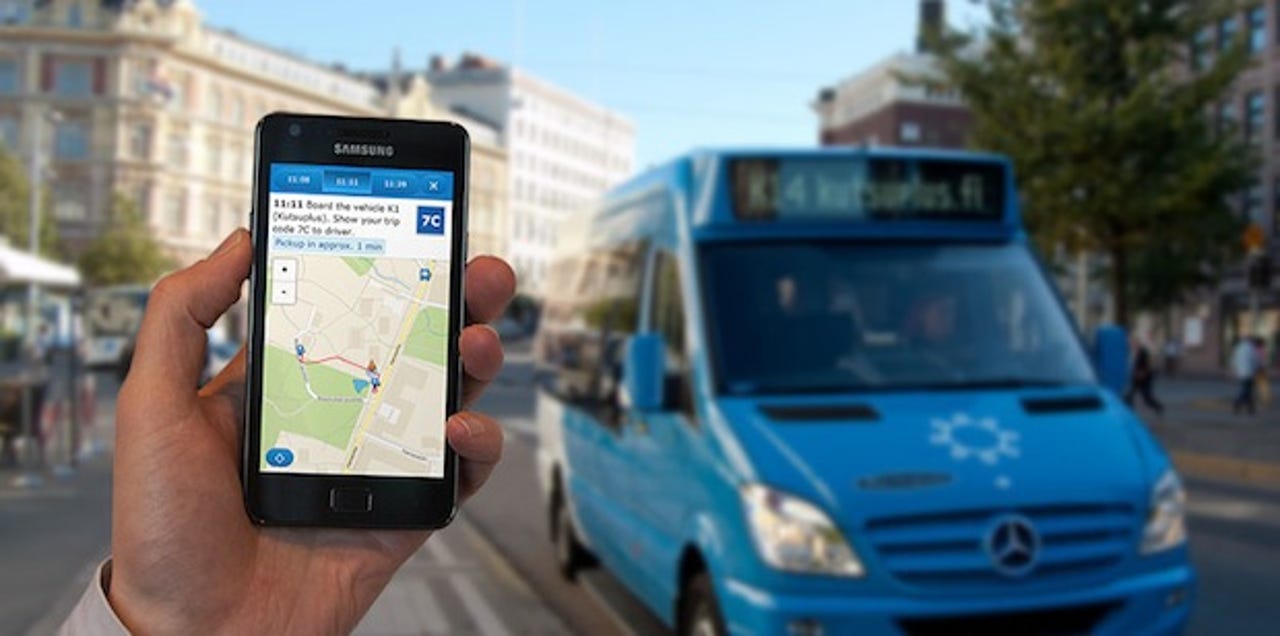Death of the car: The tech behind Helsinki's ambitious plan to kill off private vehicles


Helsinki has an ambitious plan for its future. By 2025, the Finnish capital intends to revamp its public transport system to such an extent that private car ownership becomes pointless. The bold initiative is not just about providing more buses, trains, or taxis, but about creating a new transport infrastructure based on cutting-edge technology and a single, affordable payment system.
The theory goes like this: imagine a family that has opted not to own a car. When they want to drop the kids off at school, they simply arrange an on-demand bus service instead. They use ridesharing and buses to get to work, and in the holidays they rent a car to travel to their summer house. When they need to get around Helsinki, they use city bikes, renting a locker to store any heavy bags. If the weather changes while they're out cycling, a journey planner will alert them and suggest another way of reaching their destination without getting soaked.
Under the plan, all these services will be accessed through a single online platform. People will be able to buy their transport in service packages that work like mobile phone tariffs: either as a complete monthly deal or pay as you go options based on individual usage. Any number of companies can use the platform to offer transport packages, and if users find their travel needs change, they'll be able to switch packages or moved to a rival with a better deal.
It sounds like part Google Maps, part City Mapper, part Boris Bikes, part Uber, and part capitalist free for all — but the Helsinki vision isn't as farfetched as it might sound.
The inspiration behind an initiative that would send many cityplanners running for the hills comes from a master's thesis by transport engineer Sonja Heikkilä. Commissioned by the Helsinki City Planning Department, Heikkilä's thesis argued young people's changing attitudes towards cars, coupled with the growing functionality and takeup of mobile technology, could transform the way people get around the capital.
"The vision is that all kinds of [transport] services will be used together through a single portal," Heikkilä says. "In addition to traditional public transport, it would include taxis, car-sharing, and services that don't even exist yet. A proactive route planner will suggest journeys based on real-time traffic data and alert users to changes caused by accidents or changes in weather conditions."
It's a drastic change from the current system. Like most cities, public transport in Helsinki is currently run entirely by local authorities, combining traditional bus, train and tram services alongside a mixture of licensed and private taxis.
Technology in place
Moving to the system envisioned by Heikkilä will be no small task, but the foundations are already being laid.
In June the Finnish Ministry of Transport and Communications rolled out Traffic Lab, a real-time traffic information service being developed in partnership between local government and businesses. Traffic Lab will compensate companies in the programme for anonymous traffic data they collect from private vehicles whose owners have opted into the system. The data could include, for example, traffic information and driving logs from traffic apps or in-car navigation systems and will be collected through a mixture of existing in-car systems and newly-installed ones, producing a combination of information over GPS, short-range radio signals and mobile networks.
"I now declare Finland as the country for open traffic experiments – Finland is a Traffic Lab," proclaimed Henna Virkkunen, Finland's transport and local government minister, in June.
The aim is to install Traffic Lab-compatible devices in up to 60,000 vehicles, with the scheme running until the end of 2015. Then, the data will be made available to any interested company, Finnish or foreign, and used to plan, audit, and research the new transport services required for the 2025 plan.
What new transport services could be used to fill the immense gap that would be left by any major drop in private car use? HSL, the Helsinki Regional Transport Authority, admits it doesn't yet have all the answers, but one interesting new service already in operation could point the way.
HSL has been trialling Kutsuplus (which translates from the Finnish as 'Invitation Plus'), a clever on-demand minibus service, since 2013. Passengers book a Kutsuplus minibus online. Once the request is filed, the Kutsuplus system determines which of a 15-strong fleet of minibuses is best positioned to collect the passenger and take them to their destination. The minibus is then dynamically rerouted by the system — such changes happen all along the journey as the minibus collects and drops off new passengers throughout the city, who all have access to free wi-fi along the way.
The service uses a proprietary platform developed by Finnish tech start-up Ajelo which it claims can be scaled up to support fleet sizes of more than 1,000 vehicles. To make the service work, the system needs be able to do millions of calculations in a day. For example, during one busy day in May, 8,000 separate trip requests were made by the users of the service. The system made five million A-to-B route evaluations, adjusting the routes of a fleet of 10 vehicles, each with nine seats, operating for around 16 hours during that day — all on the fly.
Currently Kutsuplus has more than 13,000 registered users and payment — a trip costs less than a taxi but more than a bus — is made before the journey using a virtual ‘Trip Wallet', part of the Kutsuplus website. Money is loaded into the wallet via online payment services or credit card and the same wallet can be shared between several family members or between workers in the same company.
At the moment the service uses a web-based UI optimised both for desktop use and mobile devices, but a family of mobile apps is under development which will allow for additional payment options beyond those found in the Trip Wallet.
But even the online payment options are primitive compared to what Helsinki is planning.
"The city wants to build a framework for an open market where companies can operate and offer their services in different combinations. The City doesn't want to decree what services are offered, but help to facilitate the establishment of an ecosystem that enables private companies to produce a variety of them," Heikkilä says. "There would be several commercial [transport] operators offering these services, in the same way as in telecommunications today. The customers could choose the operator and the service package they want."
The best part of this approach is passengers can vote with their feet: if they aren't satisfied with the package offered by one transport provider, they can switch to another.
Bumps in the road
But data and services are only half the battle. Equally important is giving them the platform to flourish — and that currently presents a problem.
"At the moment, the Finnish laws stipulate quite strictly what kinds of services are offered and there isn't much room for innovation," Heikkilä says.
It's something Teemu Sihvola, CEO of the startup Ajelo which created the platform behind the Kutsuplus service, also agrees will need to change. "To make [a car-free Helsinki] happen in just 10 years requires not only innovation but also courage from the public sector," he says. "New innovations in transport have to work hand in hand. Not competing against each other but complementing each other to provide a service network that in time will make private cars obsolete."
The first of several necessary changes will begin in early 2015 when a pilot project will launch in Vallila, a borough of Helsinki. The pilot will test a new kind of a service package based on existing transport services, including trains, trams, buses, parking, taxis, car-sharing, and Kutsuplus.
The details of the pilot are still in the planning phase and it will be the first of many, but the aim is to create a single mobile user interface through which all mobility services can be accessed and paid for. Users can easily monitor their monthly transport costs and optimise how they use different services, helping them to see when the use of a car isn't economical or necessary.
"The technology elements needed to build this kind of transport operator-based system is starting to be there but we need a structure that enables building the system," says Sampo Hietanen, CEO of ITS (Intelligent Transport Systems and Services) Finland.
"This includes legal challenges like getting rid of the monopoly in selling public transport tickets. The biggest technological challenges are in the validation of payments, as there is no unified system in use, and in enabling different systems to communicate with each other.
"Helsinki is planning to be the first city in the world to open up different public transport-related data, like live traffic data and its payment system, is a huge step."
Winding road ahead
While Finland is aiming to be first, it isn't alone. Neighbouring Sweden is currently trialling its UbiGo service in Gothenburg which combines public transport, car-sharing, rental car service, taxi and a bicycle system in a single app alongside 24/7 support and a gamefication element for those who choose environmentally-friendly options. Similar trials are also underway in Austria and Germany, among other countries.
More widely the European Union has also detailed its objective of combining a user's mobility and transportation needs under a single service agreement. Perhaps predictably, that meeting was hosted in Helsinki. The city seems convinced that if it can lead by example, others will follow.